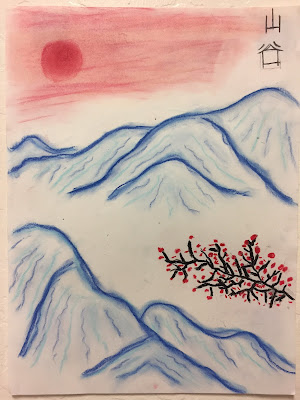Many cultures have influenced Japan’s art, but it has distinct characteristics such as elegance in form and design. Japanese art honors nature’s splendor as seen in many landscape gardens, woodblock prints, and sculptures. Koi fish are often found in Japanese meditative landscape gardens. Students studied the history of the carp, or koi in Japanese. Originating in central Asia, Japanese farmers began keeping them for aesthetics in the 1800s. Over the years, koi fish meaning and symbolism has become iconic around the world. After sketching their koi fish on drawing paper, students used ink brush pens and colored pencils to create their work.
Tuesday, May 16, 2017
Monday, April 17, 2017
5th GRADE PERSPECTIVE PROJECTS
One of the biggest discoveries in art was during the Renaissance: linear perspective. Students studied artwork by Renaissance painters such as Da Vinci and Raphael, and compared them with Medieval paintings before perspective was discovered. We discussed how drawing one-point perspective is challenging because we change the angles of lines that we know to be parallel in real life, called orthogonal lines. These lines go back into space and converge to a single point called the vanishing point, which is located on the horizon line. Students practiced identifying the horizon line, vanishing point, and orthogonal lines in famous works of art, and then drawing examples of one-point perspective using rulers. We used a photograph of a pathway with trees going back into space as a reference photo for our project and completed the drawing using oil pastel techniques such as stippling and scumbling for texture in the landscape.
4th GRADE CHINESE HANGING SCROLLS
4th graders just finished studying ancient art of China. We learned about porcelain pottery, calligraphy, and different types of scrolls. These types of artwork are significant to Chinese culture and are also used today in contemporary Chinese art. Students viewed several hanging scrolls of vertical landscapes, which would be hung up for decoration. In Chinese culture there is a great appreciation for nature,so we often see this reflected in the artwork. Chinese landscapes included intricate brushwork as well as blended areas to give the appearance of mist in the distance, which we were able to replicate with soft pastels. Students created their landscapes by layering mountains and valleys. They included a cherry blossom tree in the foreground with a sunset in the background to show depth of space. They completed their projects by writing the Chinese characters for "mountain" and "valley." Chinese calligraphy is considered a form of art, and would often be incorporated and written directly on the artwork, such as a piece of poetry or the title of the work.
Monday, February 27, 2017
5TH GRADE MICHELANGELO INSPIRED HAND DRAWINGS
Michelangelo
Buonarroti was talented in many fields including sculpture, painting, poetry,
and architecture. He studied human anatomy to perfect realistic qualities of
his subjects in his work such as the ceiling of the Sistine Chapel and the
statue of David. 5th graders studied their hands and learned how to
draw from close observation to depict contours and a range of values to achieve
realism. They shaded their hands using a hatching or cross-hatching technique
as Michelangelo and other Renaissance artists used in their sketches.
Monday, January 30, 2017
4th GRADE UNICORN TAPESTRIES
In their Middle
Ages Unit, 4th graders studied the Hunt of the Unicorn tapestries. Students
discussed the stories that these woven artworks told. They studied and
practiced drawing the proportions of a horse, and created their own unicorn
tapestry using colored pencils and oil pastels on black drawing paper. They
finished their tapestries by adding small plants and details similar to the
nature designs surrounding the Unicorn in Captivity. We are currently finishing up our last project in the Middle Ages, Gothic Cathedrals!
Student work
Unicorn in Captivity
Monday, January 9, 2017
SECOND QUARTER WORK
Dear Trivium Families,
Welcome back after a safe and happy winter break! The end of the second quarter was a busy one, and I wanted to catch everyone up with what we were working last quarter.
Welcome back after a safe and happy winter break! The end of the second quarter was a busy one, and I wanted to catch everyone up with what we were working last quarter.
In 4th grade, students studied
the significance of medieval illuminated letters and their importance due to
the lack of education for the common people during the Middle Ages. Monks
created these highly decorated symbols for people to understand a story or
meaning, such as the Chi Rho page from the Book of Kells. Each student chose
one of their initials to create an illuminated letter with markers and metallic
pens on brown drawing paper to mimic the beautiful and intricate artwork
created during that time.
In 5th grade, we're still in our large Renaissance unit and have two more projects yet to complete since this was a massive time for discoveries made in the arts. Students learned that the Renaissance,
or “rebirth,” was a time of humanism. The Renaissance looked for realism and
human emotion in art. 5th graders created a lifelike still life
composition using soft pastels after viewing several Renaissance still
lifes. Using their knowledge of color, form, value, and light, students created
subtle changes across the objects to make them appear realistic. They included all
parts of a form and carefully blended their pastels as they shaded the
fruit, vase, and background.
Subscribe to:
Posts (Atom)














































